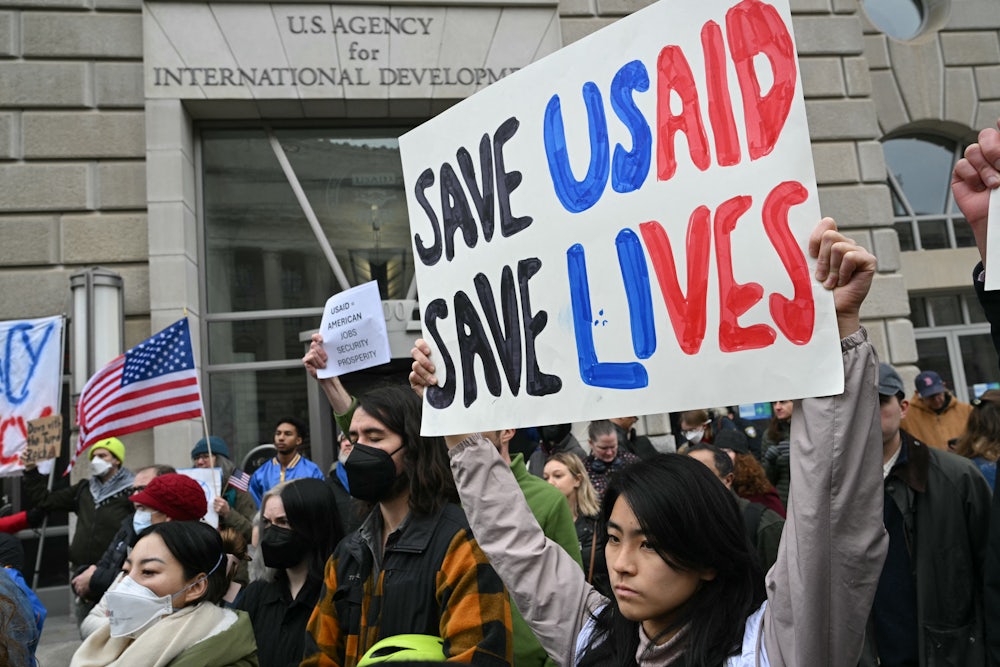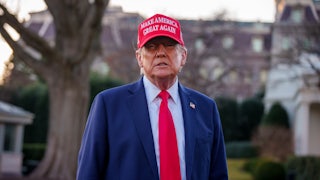Within hours of taking office, Donald Trump issued a sweeping executive order suspending all U.S. foreign aid. Four days later, his administration followed up with a stop-work order for USAID, demanding that staff and agency contractors cease all work. Almost immediately, hundreds were laid off and USAID-supported organizations around the world closed their doors. HIV patients were turned away from U.S.-backed clinics, medical centers in Gaza shuttered, and first responders in Ukraine told to stand down. Groups fighting malnutrition and famine in Sudan now say they have just days before they run out of supplies.
That was as of last Friday. On Saturday, it got worse. Agents from Elon Musk’s Department of Government Efficiency raided the offices of USAID and assumed control of the agency’s personnel and payment files. Soon thereafter, Musk approvingly reposted X users who shared malicious conspiracies about USAID and its work around the world. “USAID is a criminal organization,” Musk posted. “Time for it to die.”
And now, for all intents and purposes, USAID is dead—murdered by Elon Musk and Donald Trump.
The USAID website and social media accounts have been taken offline; photos and the USAID logo have been stripped from the walls of the agency’s headquarters in D.C., and as of Monday, USAID’s remaining staff were told to stay home.
The most powerful man in the world and the richest man on the planet have joined forces to kill the one government agency that does the most to support the poorest and most vulnerable people in the world. There will be consequences. The sudden and swift demise of USAID will cause ripple effects that will be felt around the world. At first, these will be felt by millions of people who relied on USAID’s support. But Americans will also suffer. And the geopolitical implications of a United States unable and unwilling to engage in development and humanitarian assistance may reverberate for years and decades to come.
USAID was born in an era of both idealism and geopolitical rivalry. John F. Kennedy founded the agency in 1961 to demonstrate American values and stem Soviet influence in the developing world. “There is no escaping our obligations: our moral obligations as a wise leader and good neighbor in the interdependent community of free nations—our economic obligations as the wealthiest people in a world of largely poor people—and our political obligations as the single largest counter to the adversaries of freedom,” he told Congress in a special address in March 1961, announcing a massive expansion of U.S. foreign assistance.
Since then, USAID has striven to strike a balance between providing aid and development for purely humanitarian ends and also advancing more straightforward American interests worldwide. Sometimes these twin imperatives more directly coincided, like American support for Ukraine’s energy grid in the midst of Russia’s invasion. Sometimes the link was more tangential, like providing maternal and newborn health services in Africa.
In all cases, USAID sought to advance American interests by demonstrating a kinder face of U.S. foreign policy. Aid delivered in crises was stamped with the motto “From the American People,” as if to show the world that America’s international engagements were not always initiated at the barrel of a gun—that U.S. foreign policy, and American society itself, contained multitudes. To be sure, there was always a degree of self-interest embedded in American foreign aid, but millions of people around the world have led healthier lives because of it. Entire societies have been lifted out of poverty. People upended by conflict and disaster have had a lifeline upon which they could rely.
USAID amassed a track record of success. Over the last several decades, USAID—and American foreign aid more broadly—was a key contributor to global trends that saw extreme poverty plummet, child survival surge, and the global tide turn against infectious diseases like AIDS, tuberculosis, and malaria. As these gains in global health and development took hold, foreign assistance and development became a pillar of U.S. foreign policy. To be sure, “development” typically played a smaller role in U.S. foreign policy than diplomacy or defense. But it was a pillar nonetheless—“the three D’s,” as they are known.
Now that pillar has been smashed, and we are about to see the implications of development being stripped as a guiding force in U.S. foreign policy.
Already, HIV patients have been turned away from clinics that provided antiretrovirals as part of the hugely successful PEPFAR program. This may potentially cause a surge in viral loads in people, causing a resurgence of AIDS and the proliferation of drug-resistant HIV. (While the administration did issue a waiver to ostensibly keep PEPFAR going, those implementers that are still operational are nonetheless wary and apparently scaling back their services.)
Economies in poorer countries with which USAID has partnered may also start to suffer. USAID works with governments, nongovernmental organizations, and businesses in countries friendly to the United States to help build market economies, support energy systems, boost agricultural productivity, and implement other activities designed to foster self-reliance and resilience against economic shocks—all while making these markets more attractive for foreign investment.
The U.S. also contributes about $4 out of every $10 committed to humanitarian relief in crises. These include manmade disasters like Gaza and Sudan and natural disasters like droughts, earthquakes, and hurricanes. USAID is a dominant funder in this sector, sometimes directly, through its Disaster Assistance Response Teams, or DARTs, but mostly by supporting major international NGOs and smaller local NGOs that provide aid in times of crisis.
Perhaps the most insidious impact of USAID’s death will be on the aid sector itself. Aid and development have become a highly specialized field, populated by thousands of professionals who have gained hard-earned expertise in responding to humanitarian crises, supporting economic and social development in poorer countries, providing health care in war zones, and fighting infectious diseases.
A relatively small number of these aid professionals work directly for USAID. That is by design. USAID is a small bureaucracy, and most of its work is carried out by contractors. This includes for-profit Beltway contractors, as well as major international NGOs and local NGOs that receive substantial grants from USAID to carry out aid efforts.
These contractors, which rely on USAID funding, are now laying off workers in droves. They are substantially scaling back—some even potentially filing for bankruptcy. Even if a future administration were somehow to restore USAID, the damage done to the entire aid sector may be permanent. The companies, NGOs, and individuals with technical know-how may be lost forever.
And then, there are the long-term geopolitical implications of one pillar of U.S. foreign policy suddenly disappearing. These foreign aid cuts come at a time of surging humanitarian needs around the world, and the humanitarian system was already stretched thin, nearly to its breaking point.
With the single largest donor to humanitarian causes no longer making payments, NGOs that provide on-the-ground support to people displaced by disaster will have less food, medicine, or shelter to provide. People will die. And if they don’t die, they will move—causing even deeper displacement and political crises in some of the most volatile places in the world.
America’s soft power will also take a hit. The goodwill engendered among people receiving aid stamped “From the American People” will turn to anger and frustration as that vital aid disappears. Long-term economic development projects in countries friendly to the U.S. will shutter, demonstrating to governments in the global south that the U.S. is not a reliable partner. These governments may turn elsewhere for support—potentially to China—which is already competing with the U.S. for access to key minerals and natural resources that are fueling the global energy transition.
And for what? Killing USAID is being framed as a cost-cutting measure. But USAID and the aid it disbursed amount to less than 1 percent of the federal budget. (The defense budget is about 28 times larger.) But the real reason may be ideological. Donald Trump and Elon Musk claim that the agency is infiltrated with people who oppose the America First agenda, so killing USAID is essentially a purge. “USAID is/was a radical-left political psy op,” Musk posted on X on Monday.
The death of USAID marks a seismic shift in America’s role in the world. For decades, U.S. foreign assistance was a balance between charity and a testament to the idea that U.S. power could be wielded for good. Now that legacy has been erased in a fit of ideological vengeance. The consequences will be swift and brutal for those who relied on American aid to survive, but the deeper damage will unfold over time. As aid projects shutter, immiseration spreads, conflicts escalate, and rivals fill the vacuum left behind, history may remember this moment not just as the end of USAID but as the beginning of something far darker.










